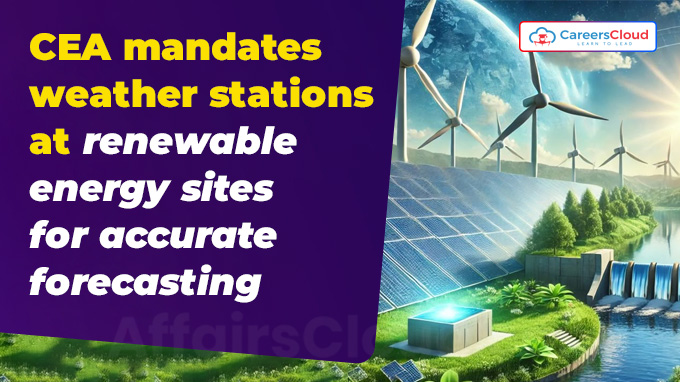
On July 8, 2025, the Central Electricity Authority (CEA), Ministry of Power (MoP) issued guidelines for solar and wind power developers to install Automated Weather Stations (AWS) at generation sites for accurate measurement of climatic conditions, a process critical for resource planning and demand forecasting.
- The guidelines released are aimed at improving accuracy of renewable generation forecasts, strengthening grid reliability, and ensuring secure cyber-physical systems at clean energy installations.
Key Highlights of the CEA Guidelines:
i.Mandatory Installation of AWS:The guidelines stipulate that all solar and wind power projects with a capacity of 50 Megawatts (MW)or more must install at least one AWS on-site.
- For projects exceeding 150 MW, a minimum of two AWS units are required. Additionally, for every 10 square kilometers(sq km) of plant area, an extra AWS must be added.
- AWS deployed with specified sensors to monitor weather parameters including solar irradiance, wind speed and direction, temperature, humidity, barometric pressure, and rainfall.
ii.Data Collection and Transmission: They are required to log encrypted weather data at 15-minute intervals, store it for six months, and transmit it securely to national agencies.
- The data stored must be shared with the National and Regional Load Dispatch Centres (NLDC/RLDC), State Load Dispatch Centres (SLDC), and Renewable Energy Management Centres (REMCs)
- In case of data loss or system failure, the project developer must inform all stakeholders within 15 minutes.
- The AWS must be equipped with Global Navigation Satellite System (GNSS) receivers for time synchronization and should be capable of encrypting and transmitting data every 15 minutes using secure communication protocols.
iii.Infrastructure and Power Supply: The AWS must be equipped with a 10 meter(m) high mast made of anodized aluminum alloy, supported by three stainless steel guy wires and a concrete platform at the base.
- The system should be powered by a solar-powered battery capable of operating for at least 20 days under full load during total cloudy and foggy conditions without requiring solar power.
- AWS should have protective enclosures to ensure continuous operation under various environmental conditions.
iv.Applicability and Exclusions: The guidelines apply to utility-scale solar photovoltaic (PV) and Concentrated Solar Power (CSP) plants, onshore wind farms, and hybrid systems, including solar-wind combinations.
- These will be applicable to both Alternating Current (AC) and Direct Current (DC) capacities of 50 MW and above.
- Battery Energy Storage Systems (BESS) are excluded from the AWS requirement unless co-located with solar or wind capacity.
v.The AWS data is expected to play a critical role in energy forecasting models, grid dispatch planning, and renewable integration into India’s electricity system, especially as the country targets 500 Gigawatt (GW) of non-fossil fuel capacity by 2030.
About Central Electricity Authority (CEA):
Chairperson – Ghanshyam Prasad
Headquarters – New Delhi, Delhi
Established – 1951




